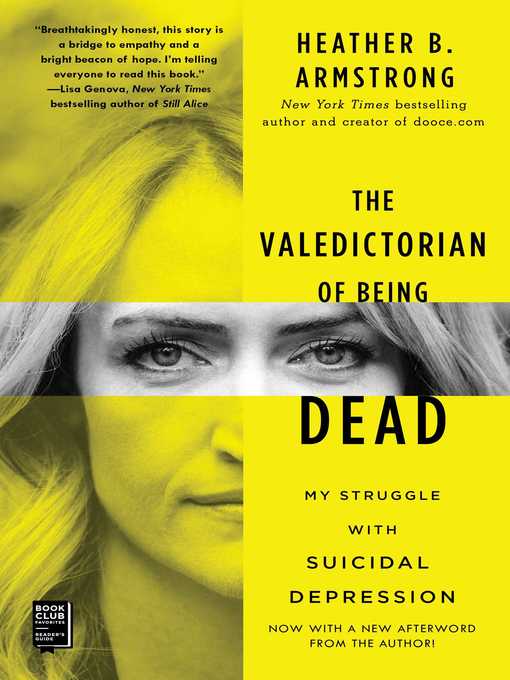
The Valedictorian of Being Dead
The True Story of Dying Ten Times to Live
داستان واقعی مردن ده بار زنده ماندن
فرمت کتاب
ebook
تاریخ انتشار
2019
نویسنده
Heather B. Armstrongناشر
Gallery Booksشابک
9781501197062
کتاب های مرتبط
- اطلاعات
- نقد و بررسی
- دیدگاه کاربران
نقد و بررسی

March 15, 2019
The candid self-portrait of a woman who, years deep in depression's clutches, mustered the courage to live again by way of dying.In her third book, acclaimed "mommy blogger" Armstrong (Dear Daughter: The Best of the Dear Leta Letters, 2012, etc.), the founder of the popular website dooce, tells the intriguing story of how she was put into a coma 10 times as part of a controversial experimental procedure to overcome severe clinical depression. In a narrative that is part cathartic confessional, part apology to those who stood by her through years of anguish and recovery, and part accessible explanation of a highly scientific procedure, the author takes readers on a room-by-room tour of events leading to the treatment that finally helped her overcome her depression. "I'd been almost brain-dead for fifteen minutes," she writes of the first session. "I felt fantastic! When you want to be dead, there's nothing quite like being dead. And boy, did I do dead well." Chronicling how the anesthesiologists used propofol ("the Michael Jackson drug") to induce the coma, the author writes that "the study is designed to determine if 'burst suppression'--quieting the brain's electrical activity--can alleviate the symptoms of depression." Later, she continues, "it's like rebooting a computer. Anyone who has ever had problems with a computer knows that sometimes you have to turn it on and off again several times to fix whatever glitch was causing all your applications to crash." Instead of detailing the personal hells of the glitch itself, Armstrong tactfully walks around it, poring over past failed therapies. She provides an experiential blow-by-blow chronicle of the test study, its effects on her daily life, the progressive improvement of her condition, and the reactions of her daughters, unconditionally dedicated mother, and the team of specialists overseeing the closely monitored deaths and rebirths that ultimately led to her victory.An unvarnished account of a boundary-pushing procedure and patient.
COPYRIGHT(2019) Kirkus Reviews, ALL RIGHTS RESERVED.

April 1, 2019
Cohost of the Manic Rambling Spiral podcast Armstrong (It Sucked and Then I Cried) is no stranger to breathtaking honesty. Here, the author expands on periods of postpartum depression discussed on her popular blog, dooce.com, which documents the triumphs and failures of motherhood. She writes about undergoing an experimental procedure to treat a depressive episode and suicidal ideation; a process in which she's put into a medically-induced coma and is nearly brain-dead for a brief period of time. Armstrong also touches on what you can and can't talk to family about, as the procedure led her to develop a stronger connection with her mom and stepdad, while her dad and stepmom struggled to understand an already misunderstood illness. In an effort to end the stigma, Armstrong shares her family's history of depression and anxiety, and fear of losing custody of her daughters because of mental illness. Similar to her blog, her voice comes through as she talks about leaving the Mormon Church and the challenges of professional blogging. VERDICT Besides attracting Armstrong's already large audience, this moving read will draw in fans of memoirs.--Stephanie Sendaula, Library Journal
Copyright 2019 Library Journal, LLC Used with permission.

March 15, 2019
In this revealing memoir, popular mommy blogger Armstrong shares her story of living with debilitating depression and the radical treatment she underwent to cure it. For years she controlled her depression with a mixture of prescriptions, but when their effects start fading, Armstrong experiences an 18-month period of deep depression fueled by suicidal thoughts. Scared of what will become of her and the possibility of losing custody of her daughters, Armstrong opts for a month-long experimental treatment. One of only 3 people participating, she receives 10 doctor-administered treatments, each of which induces a coma that leaves her brain-dead for a short period of time. Armstrong's detailed, honest, and conversational writing reads like a friend pouring her heart out, giving readers an emotional portrait of what it is like for individuals and their loved ones to struggle with serious depression. Her strong personality marks every page, and while she may not be for everyone, readers who enjoyed Brain on Fire (2012) by Susannah Cahalan and don't mind a less journalistic style should pick this up.(Reprinted with permission of Booklist, copyright 2019, American Library Association.)

























دیدگاه کاربران